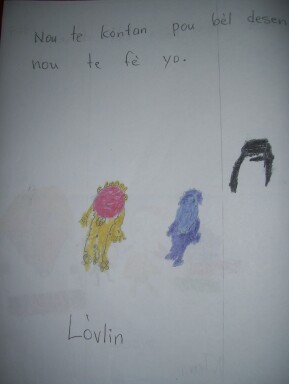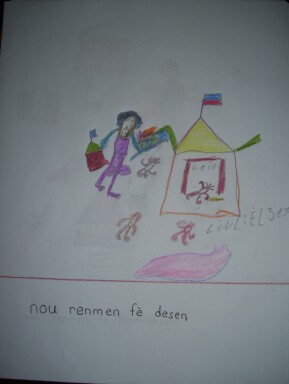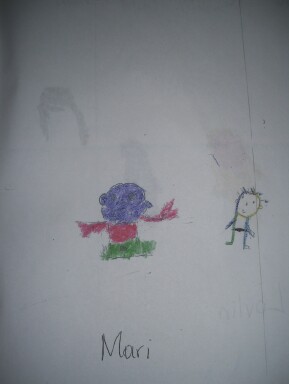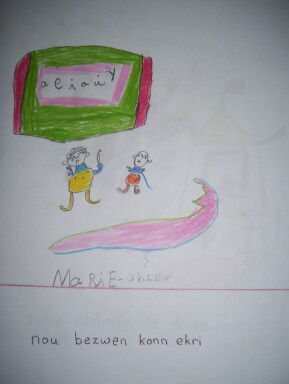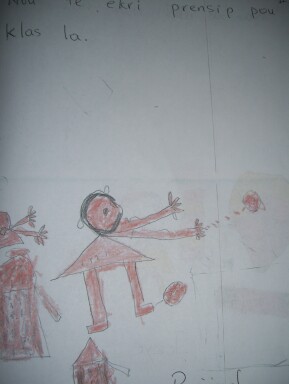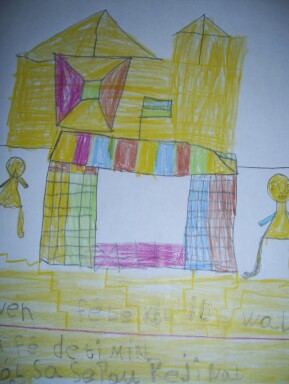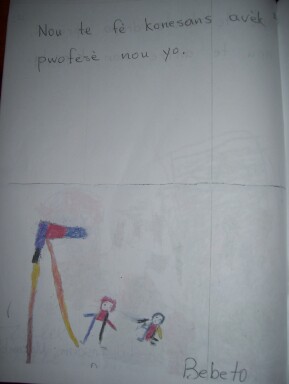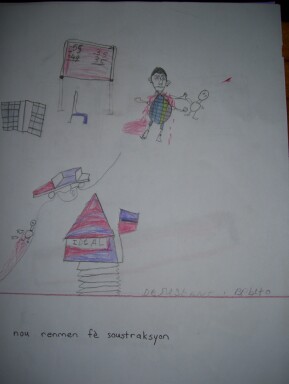In Haitian cities and towns, construction methods are fairly uniform. The standard building material is cinder blocks, made locally, often by men with no more equipment than a metal form and a shovel. People with the means will then cover the blocks with cement. They might even paint over that surface. Poured concrete support posts, with metal bars bent into something of a frame, are more or less plentiful depending on the builder’s means. Roofs are poured concrete, with various degrees of metal support, or corrugated tin. None of this is earthquake-proof, it turns out.
We opened my Fonkoze office in Marigo for a couple of hours Thursday morning, just to let locals have access to some cash. Staff members in particular needed to make withdrawals since they don’t normally bother to keep much cash on hand.
After opening, I went to Port au Prince. The main route passes by Jacmel. It’s a winding mountain road that sits right over the quake’s epicenter, so cars and trucks can no longer make the trip. Motorcycles work, at least for now, while there’s gas. There are a couple of places, however, that require the driver to have two men hold on to the cycle to prevent it from sliding down a sleep hill as they walk it across damaged terrain.
I went with Naël, a member of the Marigo staff, and when we got to Leyogann, we found a bus loading for the capital. The trip has cost 20 gourds for several years. The conductor was asking for 50 gourds, and no one was blinking. Everyone was anxious to get to Port au Prince, too anxious to argue about the price.
But something interesting happened. The driver got on the bus, and saw what was happening. He announced in a loud voice that he was very sorry, that he had been away from the bus for a few minutes. He didn’t know what the conductor was up to. He gave everyone a 25-gourd refund.
Leyogann itself was in ruins. It’s said that 90% of structures were destroyed. And the damage done along the rest of the road to Port au Prince was considerable. Naël was rushing to the city with me because his younger brother, a student of linguistics, was trapped underneath a collapsed classroom building. As of Thursday, members of the family who were waiting outside the building could still speak to him. As of Monday, he was still buried, but they could no longer hear his voice.
When we reached Port au Prince, we went our separate ways. I was anxious to get to Kaglo, because I had no news. Normally, it’s a bus and then a pick-up truck from Port au Prince to get to Malik, just 30 minutes by foot below Kaglo, but there was no transportation available, so I hiked up the hill from Port au Prince. I passed by the Fonkoze central office, and knocked politely at the closed front gate. When I got no response, I went around the back to discover a big gap in the wall. No one was there. The building was standing, but the cracks were so severe that to this non-engineer it appeared unusable.
The folks in Kaglo were fine. There were houses in upper Glo, the poorer half of the community, that had been completely or partially destroyed. But the people were almost entirely unhurt.
Early Friday morning, I hiked downhill to Metivier to see Elie and his brothers. After waiting for a day in front of their brother’s school as corpses were removed, they were able to identify Apocalypse on Thursday by the clothes he was wearing. His head had been crushed beyond recognition. They put what was left of him onto a plank, carried him to the closest cemetery, and bribed the attendants to put him in an available grave. Their father’s funeral would have to wait a few more days.
I spent the rest of Friday and all day Saturday walking around Port au Prince, trying to find people I needed to see. Telephone communication was and still is so poor that, even if one could be satisfied by just hearing someone’s voice, one wouldn’t most likely be able to do so. Searching the city to find the people I needed seemed like the only thing to do.
The destruction is hard to convey. Whole blocks entirely leveled. A second or third floor, or both, sitting neatly or not so neatly on the crushed floor or floors below. So much for the buildings. The air in Port au Prince is bad at all times, but the dust of wrecked buildings and the stench of rotting corpses and burning debris now combine to make it much worse than it usually is.
Every corpse one sees is a shock. I began to see them from the bus as we entered Port au Prince. They had been arranged on the median in the middle of the express road through Kafou, the capital’s main suburb to the south. Most were covered by sheets or curtains or whatever cloth was handy. But even so, one could discern in the shape of the now-stiff arms the terror they must have felt as they raised their hands towards the roofs that descended upon them. On Saturday, as I walked down and then up Delmas, one of the main roads between Port au Prince and Pétion-Ville, I was still seeing them here and there. And many more yet remain under rubble that is a long way from being cleared away.
Estimates of the dead go as high as 200,000. It’s hard to imagine how anyone will get an accurate count. Many of the buildings that fell – not just homes, but schools, churches, offices, and everything else one can imagine – were full of young or old at the time. Even so, many people are saying that we were lucky in a sense. It struck during afternoon rush hour. Had it been earlier or later in the day, many more people who were in the streets would have been indoors and, so, would have died as well.
Some, like Naël’s brother were still hoping for help. As I walked up Bois Patate on Thursday, I heard a strange bark from underneath the rubble of one fallen home. What appeared to be a family was gathered in front, trying to figure how to free its trapped dog. The scene was a reminder that the worst of the suffering was not at all over.
I knew I would need to be in Marigo on Monday to open our office. We needed to do the little we could to help Marigo lift itself up again. If nothing else, we needed to give our clients access to their savings and make remittances available to those whose friends and family abroad could send them.
Not knowing how easy transportation back over the Jacmel road would be, I chose the shorter, harder, but more certain road through the mountains. It meant spending a full day hiking across a beautiful, very rural path that leads from Kenskof, above Port au Prince, to Kajak and Segen, which are above Marigo. I spent much of the walk thinking about all the times I had made the hike for fun. This time I just wanted to get to my office.
Our whole staff met Sunday evening at 7:00 to plan our approach to the coming days. Monday we opened as scheduled. Everyone had lost a brother, a sister, a cousin, a number of friends. But everyone was willing to get back to work.
